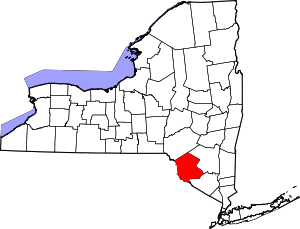Thompson, New York
Thompson is a town in southern part of Sullivan County, New York, United States. The population was 15,308 at the 2010 census. The town is named after William Thompson, an early settler.
Thompson, New York | |
|---|---|
Town | |
 Town hall on Route 42, 2013 | |
 Location of Thompson in Sullivan County, New York | |
| Coordinates: 41°38′58″N 74°40′21″W | |
| Country | United States |
| State | New York |
| County | Sullivan |
| Area | |
| • Total | 87.50 sq mi (226.62 km2) |
| • Land | 84.09 sq mi (217.79 km2) |
| • Water | 3.41 sq mi (8.83 km2) |
| Elevation | 1,476 ft (450 m) |
| Population (2010) | |
| • Total | 15,308 |
| • Estimate (2016)[2] | 14,894 |
| • Density | 177.12/sq mi (68.39/km2) |
| Time zone | UTC-5 (Eastern (EST)) |
| • Summer (DST) | UTC-4 (EDT) |
| FIPS code | 36-73627 |
| GNIS feature ID | 0979543 |
History
The town was first settled in 1749. The town was established in 1803 from the town of Mamakating. Part of the town was taken from the town of Fallsburg in 1826.
Geography
According to the United States Census Bureau, the town has a total area of 87.4 square miles (226 km2), of which, 84.1 square miles (218 km2) of it is land and 3.3 square miles (8.5 km2) of it (3.77%) is water.
Demographics
| Historical population | |||
|---|---|---|---|
| Census | Pop. | %± | |
| 1820 | 1,897 | — | |
| 1830 | 2,459 | 29.6% | |
| 1840 | 2,610 | 6.1% | |
| 1850 | 3,198 | 22.5% | |
| 1860 | 3,834 | 19.9% | |
| 1870 | 3,514 | −8.3% | |
| 1880 | 3,763 | 7.1% | |
| 1890 | 3,462 | −8.0% | |
| 1900 | 3,739 | 8.0% | |
| 1910 | 4,196 | 12.2% | |
| 1920 | 4,597 | 9.6% | |
| 1930 | 5,950 | 29.4% | |
| 1940 | 6,054 | 1.7% | |
| 1950 | 6,912 | 14.2% | |
| 1960 | 8,792 | 27.2% | |
| 1970 | 11,418 | 29.9% | |
| 1980 | 13,550 | 18.7% | |
| 1990 | 13,711 | 1.2% | |
| 2000 | 14,189 | 3.5% | |
| 2010 | 15,308 | 7.9% | |
| Est. 2016 | 14,894 | [2] | −2.7% |
| U.S. Decennial Census[3] | |||
At the 2000 census there were 14,189 people, 5,543 households, and 3,481 families in the town. The population density was 168.7 people per square mile (65.1/km²). There were 9,258 housing units at an average density of 110.1 per square mile (42.5/km²). The racial makeup of the town was 73.70% white, 16.94% African American, 0.18% Native American, 1.85% Asian, 0.03% Pacific Islander, 4.64% from other races, and 2.67% from two or more races. Hispanic or Latino of any race were 14.56%.[4]
Of the 5,543 households 30.0% had children under the age of 18 living with them, 42.4% were married couples living together, 15.2% had a female householder with no husband present, and 37.2% were non-families. 30.6% of households were one person and 11.3% were one person aged 65 or older. The average household size was 2.44 and the average family size was 3.04.
The age distribution was 26.0% under the age of 18, 7.4% from 18 to 24, 26.8% from 25 to 44, 25.5% from 45 to 64, and 14.2% 65 or older. The median age was 38 years. For every 100 females, there were 97.0 males. For every 100 females age 18 and over, there were 94.0 males.
The median household income was $35,511 and the median family income was $41,043. Males had a median income of $37,759 versus $26,692 for females. The per capita income for the town was $18,668. About 18.3% of families and 23.3% of the population were below the poverty line, including 34.9% of those under age 18 and 13.4% of those age 65 or over.
Communities and locations in Thompson
- Bridgeville – a hamlet southeast of Monticello on Route 17.
- Coopers Corners – a hamlet west of Monticello.
- East Monticello – a location east of Monticello on Route 17.
- Emerald Green – a hamlet by the east town line on Route 17.
- Ferndale – a hamlet on Route 17 between Harris and Liberty
- Glen Wild – a hamlet east of Monticello. The Anshei Glen Wild Synagogue and Glen Wild Methodist Church are listed on the National Register of Historic Places.[5]
- Harris – a hamlet north and west of Monticello.
- Kiamesha Lake – a hamlet north of Monticello on Route 42.
- Maplewood – a hamlet west of Monticello.
- Melody Lake – a location by the south town line.
- Monticello – village which is the county seat.
- Rock Hill – a hamlet southeast of Monticello on Route 17.
- Sackett Lake – a location in the southwest part of the town.
- Thompsonville – a hamlet in the east part of the town.
References
- "2016 U.S. Gazetteer Files". United States Census Bureau. Retrieved Jul 5, 2017.
- "Population and Housing Unit Estimates". Retrieved June 9, 2017.
- "Census of Population and Housing". Census.gov. Retrieved June 4, 2015.
- "U.S. Census website". United States Census Bureau. Retrieved 2008-01-31.
- "National Register Information System". National Register of Historic Places. National Park Service. March 13, 2009.
